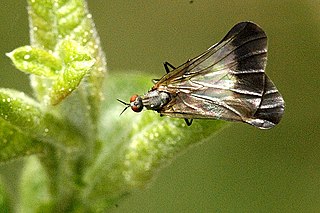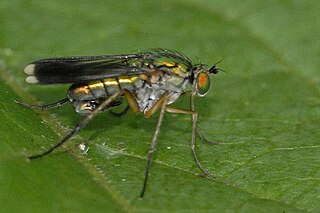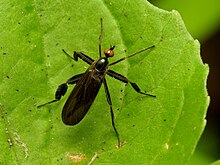
Leptoconops torrens is a species of small biting flies in the no-see-um family Ceratopogonidae. They were first mentioned in writing by Charles Henry Tyler Townsend in 1893. The name Leptoconops carteri is a junior synonym of L. torrens. They are prevalent in the southwestern and southeastern areas of the United States. In early stages of life, L. torrens flies dwell in soil, then emerge to feed and breed as fully developed adults.

Empididae is a family of flies with over 3,000 described species occurring worldwide in all the biogeographic realms but the majority are found in the Holarctic. They are mainly predatory flies like most of their relatives in the Empidoidea, and exhibit a wide range of forms but are generally small to medium-sized, non-metallic and rather bristly.

Nuptial flight is an important phase in the reproduction of most ant, termite, and some bee species. It is also observed in some fly species, such as Rhamphomyia longicauda.

A courtship display is a set of display behaviors in which an animal, usually a male, attempts to attract a mate; the mate exercises choice, so sexual selection acts on the display. These behaviors often include ritualized movement ("dances"), vocalizations, mechanical sound production, or displays of beauty, strength, or agonistic ability.

Rhamphomyia marginata is a species of dance flies, in the fly family Empididae. It is found in Europe, from Great Britain east to Romania and from Fennoscandia south to France, Austria and Hungary.

Empis borealis is a species of dance flies in the fly family Empididae. It is found in most of Europe, except the Balkan Peninsula, the Baltic Region and the Iberian Peninsula. The brown wings of the female are very broad, while the male fly’s wings are narrower.

Empis tessellata is a species of dance fly, in the fly family Empididae. It is included in the subgenus Euempis.

Empis ciliata, the black dance fly, is a species of dance fly, in the fly family Empididae. It is included in the subgenus Euempis.

Sepsis cynipsea is a European species of fly and member of the family Sepsidae. It is a coprophagous fly that feeds on dung. These flies are most commonly found around freshly laid cattle dung where they eat and reproduce. Due to human agricultural practices involving cows, these flies are now common in other areas of the world.
Diptera is an order of winged insects commonly known as flies. Diptera, which are one of the most successful groups of organisms on Earth, are very diverse biologically. None are truly marine but they occupy virtually every terrestrial niche. Many have co-evolved in association with plants and animals. The Diptera are a very significant group in the decomposition and degeneration of plant and animal matter, are instrumental in the breakdown and release of nutrients back into the soil, and whose larvae supplement the diet of higher agrarian organisms. They are also an important component in food chains.
A nuptial gift is a nutritional gift given by one partner in some animals' sexual reproduction practices.

Hylobittacus apicalis is a species of hangingfly in the order Mecoptera, and the only species within the genus Hylobittacus.

Sexual selection in insects is about how sexual selection functions in insects. The males of some species have evolved exaggerated adornments and mechanisms for self-defense. These traits play a role in increasing male reproductive expectations by triggering male-male competition or influencing the female mate choice, and can be thought of as functioning on three different levels: individuals, colonies, and populations within an area.

Poecilobothrus nobilitatus or semaphore fly is a species of fly in the highly studied family Dolichopodidae. P. nobilitatus are popular study subjects because they are easy to recognize and are of large size. They mainly reside around ponds and wet lands, where most of their hunting and mating take place. Their mating ritual is highly studied due to their distinctive mate selection behaviors.

Harpobittacus is a genus of hangingfly of the family Bittacidae found in Australia.

Lordotus pulchrissimus is a species of bee fly in the taxonomic order Diptera and family Bombyliidae. It is also frequently referred to as the desert bee fly. Few studies have been done on the biology of L. pulchrissimus, although their behavior in the wild has been observed.
Empis snoddyi is a species of dance flies in the family Empididae. It is present in the United States, specifically mountainous areas from southern Virginia to northern Georgia. These flies are known for their distinctive mating ritual in which the males offer the females a large empty sack filled with hundreds of silk bubbles.
Hirtodrosophila mycetophaga is a fairly large drosophilid fly, with a mean length of 4.0–4.5 mm. It has thus far only been found in Australia. It mates on bracket fungi, preferentially those with a lighter-colored surface in order to enhance mating displays. In addition to these physical displays, flies emit specific sounds in order to attract and ultimately copulate with females.

Tokunagayusurika akamusi is a midge fly species of the family Chironomidae, commonly called "nonbiting midges" or "lake flies."

Teleopsis dalmanni, synonym Cyrtodiopsis dalmanni, also known as the Malaysian stalk-eyed fly, is a species of fly in the family Diopsidae. T. dalmanni flies possess lateral elongations on their head capsules called eyestalks. These eyestalks play an important role in mate selection and as a result physical characteristic of the fly has been the subject of several studies on sexual selection, natural selection, and mating behavior.




















